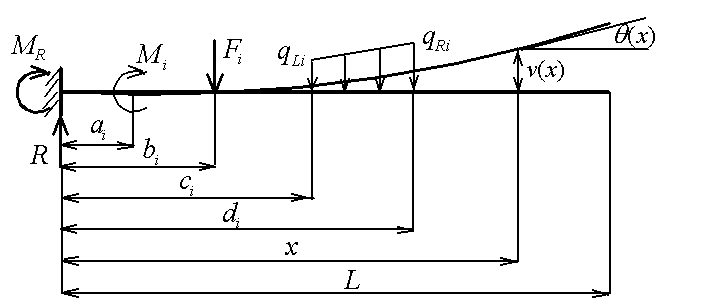
| Instructions |

|
|
For calculation of reactions, shear forces, bending moments and
deflections of cantilever beam, at the first step one has to enter the length of the beam L, number of couples (external moments), concentrated and distributed loads, which are applied to the beam and submit these data. At the next steps user has to enter characteristics of each load: the values Mi and coordinates ai of the external moments, the values Fi and coordinates bi of the concentrated loads, left qLi and right qRi values of the linearly distributed loads and corresponding left ci and right di coordinates of the distributed loads. User should submit these data for each i-th load. For the uniform distributed load assume qLi=qRi.
All coordinates must be positive and less then or equal to the length of the beam. According to the figure they are the distances of the load points from the left end of the beam. All load directions shown in the figure are positive. Use negative values entering data for loads with the opposite directions. There are no restrictions on the total number of loads except the readability of the obtained result. Please use the same system of units throughout the calculation. For instance, if you use force unit N and length unit m, the unit of distributed load and couple should be N/m and Nm respectively. Obviously, the result of calculation will have the same unit system in this case: shear force – N, bending moment – Nm. For statically determined beams, shear forces and bending moments do not depend on such structure properties as elasticity modulus of material E, moment of inertia I of beam cross section about its neutral axis. The product EIv also does not depend on these structure properties. For this reason the distribution of deflection along the length of the beam is represented by product EIv (whose unit will be Nm3 for our example). Such representation of deflection is convenient when a beam is not designed yet and its properties are not defined. To obtain the deflection itself for the specific beam this result (EIv) should be divided by EI. As a result you will obtain reactions, shear force, bending moment and deflection diagrams, extreme values of these functions as well as their values at the ends of each segment of the beam. In addition all steps of the solution will be represented by formulas. |